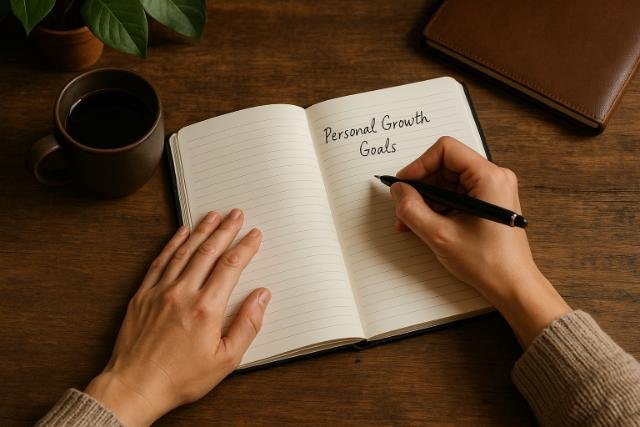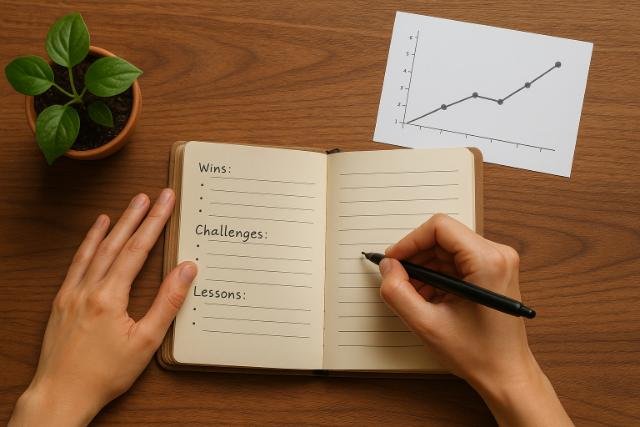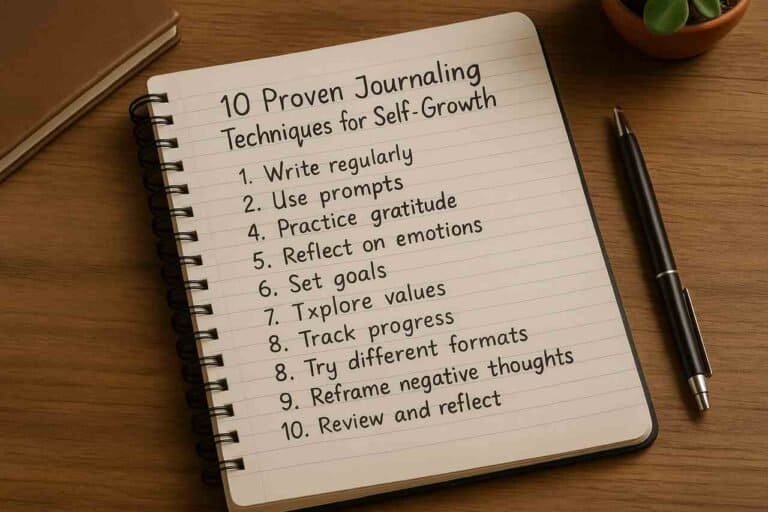Journaling is a timeless tool that has guided thinkers, creators, and ordinary people toward deeper self-understanding for centuries. It is not just about keeping a diary; it is about exploring your inner world, tracking your growth, and shaping your mindset. In today’s fast-paced life, journaling serves as a powerful anchor that brings clarity, calm, and purpose. Whether you want to set goals, process emotions, or strengthen your mental resilience, journaling provides a safe and creative outlet to express your authentic self. This guide explores 10 proven journaling techniques that can significantly accelerate your journey of self-growth and transformation.
Establish a Consistent Journaling Routine
Consistency is the backbone of any successful journaling practice. Writing occasionally might offer temporary relief, but long-term growth comes from sustained reflection. When you create a daily or weekly habit, journaling becomes second nature a sacred space where you can process thoughts, set intentions, and realign your life direction. Regular entries allow you to detect emotional and behavioral patterns over time, making your self-discovery process both structured and insightful.
Choose the Right Time and Place
The environment in which you write greatly influences your focus and comfort. Early mornings often bring mental clarity and freshness, making it a great time to set intentions. Evenings, on the other hand, are ideal for reflecting on daily experiences. The key is consistency: pick a time and stick to it. Your journaling space should be free from distractions, perhaps a cozy corner with soft lighting or a calming candle. Creating this familiar environment helps your brain associate journaling with peace, mindfulness, and growth.
Create a Sustainable Habit Loop
Habits form when routines are linked to existing behaviors. Pair journaling with an activity you already do, such as drinking morning coffee or winding down before sleep. Start small, with just a few sentences a day, and gradually extend your writing time. You can even use habit-tracking apps or simple checklists to stay accountable. Over weeks and months, this small daily ritual strengthens your sense of discipline and self-connection, transforming journaling into an essential part of your self-care routine.
Practice Gratitude Journaling Daily
Gratitude journaling is one of the most effective tools for shifting perspective. It helps you focus on what is working rather than what is lacking, rewiring your brain toward positivity and appreciation. By documenting the things you are thankful for, you train your mind to notice the blessings and opportunities present in your everyday life. This emotional shift can reduce stress, boost happiness, and foster resilience even during difficult times.
Identify Specific Gratitudes
To make gratitude journaling meaningful, go beyond vague statements. Instead of simply writing “I’m grateful for my job,” describe why. For instance, “I’m grateful for my job because it allows me to connect with inspiring people.” Specific gratitude builds emotional engagement and authenticity, helping you relive positive experiences as you write them. The more detail you include, the stronger the emotional imprint becomes, reinforcing a habit of mindful appreciation.
Use Morning or Evening Reflection Prompts
Morning entries prepare you for the day ahead with optimism, while evening reflections allow you to close your day with peace and perspective. Use prompts like “What are three things I appreciated today?” or “Who made my day better?” These simple yet powerful questions train your brain to recognize good moments, even in challenging situations. Over time, you will notice a mindset shift as your focus naturally gravitates toward joy and contentment.
Set Personal Growth Goals Through Journaling

Goal-oriented journaling gives your thoughts direction and your dreams structure. When you write your goals, you transform vague ideas into tangible intentions. This process helps you articulate what you truly want, why it matters, and how you plan to achieve it. Your journal becomes a personal development blueprint, a place to brainstorm, plan, and reflect.
Use SMART Goal Framework
The SMART method, which stands for Specific, Measurable, Achievable, Relevant, and Time-bound, is the most reliable structure for journaling goals. Writing a SMART goal like “I will exercise for 20 minutes every morning for 30 days” turns intentions into commitments. Each element of SMART ensures your goals are realistic and trackable. This level of clarity builds self-trust and helps you maintain focus as you move toward growth milestones.
Reflect and Adjust Regularly
Self-growth is an evolving process. Use your journal to revisit your goals every week or month. Write about what is working, what is not, and how you can adjust. If you did not meet a goal, explore the reasons without self-judgment. Perhaps your priorities shifted or the goal was not aligned with your values. These reflections transform mistakes into lessons and keep your growth intentional rather than accidental.
Embrace Stream-of-Consciousness Writing
Stream-of-consciousness writing, often called free writing, is a liberating technique that allows thoughts to flow uncensored. It is one of the most powerful ways to bypass the logical mind and access your subconscious emotions. By writing continuously without editing, you tap into creativity, release emotional tension, and discover new insights about yourself.
Write Without Editing
Set a timer for 10 to 20 minutes and let your pen move freely. Do not worry about punctuation, grammar, or coherence. The goal is flow, not perfection. This unfiltered writing helps you uncover hidden worries, desires, or ideas that might be buried beneath daily distractions. It is especially effective during times of stress, confusion, or creative block.
Discover Hidden Patterns and Insights
After finishing a few sessions, reread your entries. You may notice recurring phrases, emotions, or metaphors. These patterns reveal deeper truths about your mindset and emotional landscape. For instance, frequent mentions of “fear” might indicate an area of insecurity that needs healing. Recognizing these unconscious themes empowers you to address them consciously, facilitating emotional maturity and transformation.
Use Reflective Prompts for Deep Self-Discovery
Sometimes, self-reflection needs a spark, and that is where prompts come in. Reflective prompts provide direction when you are unsure what to write about. They encourage introspection, allowing you to explore feelings, values, and experiences from new perspectives. Regular use of prompts enhances self-awareness and emotional intelligence.
Explore Emotionally Engaging Prompts
Prompts such as “What is one thing I need to forgive myself for?” or “What does success mean to me?” challenge you to think deeply. These questions often bring buried emotions or limiting beliefs to the surface. Writing about them helps you process unresolved feelings and develop greater compassion for yourself. The more honest your responses, the more transformative the results.
Track Emotional Patterns Over Time
After journaling with prompts for a few weeks, review your past entries. Notice how your tone, focus, or emotions shift over time. Are you becoming more self-assured, more forgiving, or more mindful? Recognizing emotional progress strengthens your self-awareness and helps you stay aligned with your growth journey. This awareness can also improve relationships, decision-making, and emotional stability.
Incorporate Visualization and Affirmation Writing
Visualization and affirmation journaling combine the power of belief with the structure of written expression. They train your subconscious mind to align with your aspirations by reinforcing positive thoughts and mental imagery. By repeatedly writing about your desired outcomes, you begin to think, feel, and act in ways that bring them closer to reality.
Write Positive Affirmations Daily
Affirmations are powerful declarations of self-belief. Writing statements like “I am capable of achieving my goals” or “I am becoming more confident each day” reinforces empowering thought patterns. The key is repetition and emotion. Write them daily and say them aloud if possible. Over time, affirmations reshape your internal dialogue, replacing self-doubt with confidence and clarity.
Create Visualization Scripts
Visualization journaling involves describing your ideal scenarios in vivid detail. Imagine your dream job, your happiest day, or your best self. Write as if you are already living it: “I wake up energized, grateful, and ready to make a difference.” By visualizing success through words, you strengthen the neural pathways that help manifest those realities. This method also boosts motivation and emotional alignment with your long-term vision.
Combine Reflection and Action with Progress Tracking

Self-growth thrives on awareness and action. Progress tracking bridges the gap between intention and achievement by helping you measure improvement over time. When you record your wins, challenges, and lessons, you gain a tangible sense of evolution that words alone cannot always capture. Your journal becomes both a mirror and a map of your journey.
Develop a Personal Progress Log
Design a dedicated section in your journal to track growth across areas such as health, career, mindset, relationships, or creativity. You might use charts, graphs, or tables to visualize your achievements. For instance, track the number of times you practiced meditation or completed goals. This structure adds a sense of accountability and accomplishment, reminding you that every small step contributes to larger transformation.
Celebrate Achievements and Learn from Setbacks
Progress is not linear. There will be moments of triumph and times of struggle, and both deserve reflection. Use your journal to acknowledge progress with pride, but also to analyze setbacks without criticism. Ask questions like “What can I learn from this experience?” or “What will I do differently next time?” These reflections transform challenges into stepping stones, reinforcing emotional resilience and humility.
Overview of 10 Proven Journaling Techniques for Self-Growth
| Technique | Primary Focus | Key Benefit |
| Consistent Routine | Habit Formation | Builds discipline and mindfulness |
| Gratitude Journaling | Positivity | Enhances emotional well-being |
| Goal Setting | Clarity | Directs personal growth efforts |
| Stream-of-Consciousness | Emotional Release | Unlocks creativity and authenticity |
| Reflective Prompts | Self-Discovery | Deepens self-understanding |
| Visualization Writing | Manifestation | Strengthens confidence and belief |
| Affirmation Writing | Mindset | Reprograms thought patterns |
| Progress Tracking | Accountability | Measures growth over time |
| Emotional Mapping | Awareness | Identifies behavioral triggers |
| Future Self Letters | Perspective | Aligns current actions with vision |
Sample Weekly Journaling Structure
| Day | Focus Area | Example Prompt |
| Monday | Gratitude | “What am I most thankful for right now?” |
| Tuesday | Goal Setting | “What is one small step toward my dream?” |
| Wednesday | Emotional Reflection | “What emotion dominated my day?” |
| Thursday | Affirmation Writing | “Which belief am I strengthening today?” |
| Friday | Free Writing | “What is on my mind right now?” |
| Saturday | Progress Review | “What did I achieve this week?” |
| Sunday | Visualization | “What does my ideal next week look like?” |
Conclusion
Journaling is far more than writing; it is a mirror of the soul and a compass for self-evolution. When practiced consistently, it builds emotional intelligence, mental clarity, and spiritual depth. Through gratitude, reflection, visualization, and goal-setting, you gain control over your inner world, enabling outer transformation. Every page you fill becomes a step closer to your most authentic, empowered self. The beauty of journaling lies in its simplicity. One pen, one page, and an open heart can change everything.
Explore more insightful and valuable content on our blog journalingtechniques! Stay updated with helpful tips, expert advice, and in-depth articles that enhance your knowledge.
FAQ’s
Start with 10 to 15 minutes daily. It is not about the length but about regularity. Short, consistent sessions have a greater impact than occasional long entries.
You can use any notebook, digital app, or voice-to-text tool that feels natural. The best journal is the one you will actually use regularly.
Create a ritual around it. Light a candle, make tea, or play calming music. Using prompts and reviewing past entries also helps you stay inspired.
Yes. Writing helps organize racing thoughts, process emotions, and reduce mental clutter. It is a proven mindfulness tool for emotional balance.
Yes. Revisiting old entries reveals how much you have grown and offers valuable lessons. It can also provide motivation and closure for past challenges.
Morning journaling nurtures focus and intention for the day, while evening journaling encourages reflection and gratitude. The best time is whenever you can write consistently.

